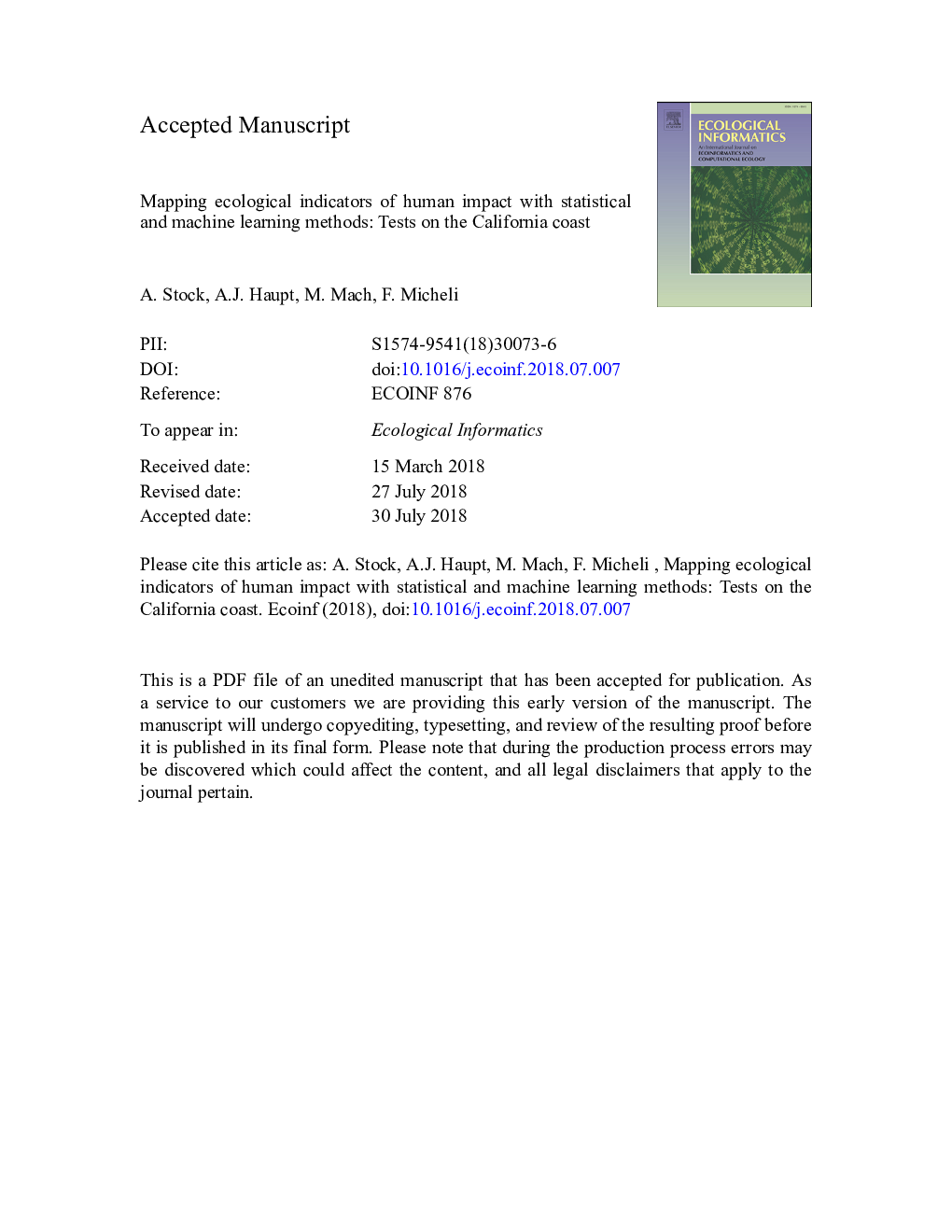| کد مقاله | کد نشریه | سال انتشار | مقاله انگلیسی | نسخه تمام متن |
|---|---|---|---|---|
| 8845784 | 1617187 | 2018 | 34 صفحه PDF | دانلود رایگان |
عنوان انگلیسی مقاله ISI
Mapping ecological indicators of human impact with statistical and machine learning methods: Tests on the California coast
ترجمه فارسی عنوان
نقشه برداری شاخص های اکولوژیکی تأثیر بشر با روش آماری و آماری ماشین: آزمون در ساحل کالیفرنیا
دانلود مقاله + سفارش ترجمه
دانلود مقاله ISI انگلیسی
رایگان برای ایرانیان
کلمات کلیدی
ترجمه چکیده
اکوسیستم های ساحلی در معرض چند تن از عوامل استرسزا مانند ماهیگیری، آلودگی و تغییرات اقلیمی هستند. مدیریت ساحلی مبتنی بر اکوسیستم نیاز به درک آن دارد که ترکیبی از عوامل استرسزا چندان اثرات تجمعی زیادی دارد و در مواردی که اقدامات لازم جهت رسیدگی به تأثیرات ضروری است، ضروری است. با این حال، اثرات عوامل استرس زا در اکوسیستم های ساحلی و دریایی غالبا غیر خطی و تعاملی هستند. این پیچیدگی با استفاده از مدل های فضایی معمول برای نقشه برداری اثرات انسانی به دست نمی آید. به این ترتیب، مدل های یادگیری آماری و ماشین های آماری مثل جنگل های تصادفی به عنوان رویکرد مدل سازی جایگزین برای شناسایی عوامل استرس زا و پیش بینی های فضایی اثرات ترکیبی آنها مورد استفاده قرار می گیرند. با این حال، آزمون مهارت های پیش بینی چنین مدل ها محدود شده است. بنابراین، ما بررسی کردیم که چگونه ده روش آماری و ماشین های یادگیری، سه شاخص اکولوژیکی شرایط اکوسیستم دریایی ساحلی (تنوع زیستی زیست شناسی، زیست توده ماهی، و تنوع زیستی بین کوهی) را از کالیفرنیا، ایالات متحده آمریکا پیش بینی کرد. داده های فضایی نشان دهنده تنشزای انسان شناسی و استفاده از اقیانوس و همچنین شیب های طبیعی به عنوان پیش بینی کننده استفاده شده است. خطاهای پیش بینی مدل ها با اعتبار سنجی متقابل بلوک فضایی محاسبه شد. بهترین مدل ها بدست آوردن خطاهای مربعی حدود 25٪ کمتر از یک مدل صفر برای تنوع زیستی کلم و زیست توده ماهی است؛ هیچ کدام از مدل های مورد آزمایش برای تنوع زیستی تناوبی سنگی به خوبی کار نمی کرد. این مدل ها روندهای کلی را در بر گرفت، اما تغییرات محلی شاخص ها را نادیده نگرفت. برای تنوع زیستی لوزی، بهترین روش انجام رگرسیون مؤلفه اصلی بود. برای بیوماس ماهی، بهترین روش انجام شده درختان رگرسیونی افزایش یافت. با این حال، پس از تنظیم، این مدل شامل هیچ گونه تعامل بین عوامل استرس زا و رگرسیون خطوط ریج (مدل خطی محدود) انجام شده تقریبا نیز. در حالیکه در روش تئوری انعطاف پذیری ماشین های یادگیری ماشین برای نشان دادن روابط حالت استرس زا و اکوسیستم نشان داده شده توسط اکولوژیست های آزمایشی، با اطلاعات ما، این انعطاف پذیری را نمی توان مهار کرد زیرا مدل های انعطاف پذیر بیش از حد به دلیل اندازه های کوچک اندازه گیری و کم سیگنال به نویز نسبت چالش اصلی برای به کارگیری انعطاف پذیری روش های آماری و یادگیری ماشین برای ارتباط شاخص های اکولوژیکی و استرس های انسانی، کسب اطلاعات مناسب تر است. به طور خاص، داده های بهتر توصیف توزیع فضایی و زمانی از کاربردهای انسانی و عوامل استرسزا مورد نیاز است. ما با بحث درباره معیارهای روش شناختی برای تحقیقات آینده نتیجه گرفتیم.
موضوعات مرتبط
علوم زیستی و بیوفناوری
علوم کشاورزی و بیولوژیک
بوم شناسی، تکامل، رفتار و سامانه شناسی
چکیده انگلیسی
Coastal ecosystems are exposed to multiple anthropogenic stressors such as fishing, pollution, and climate change. Ecosystem-based coastal management requires understanding where the combination of multiple stressors has large cumulative effects and where actions to address impacts are most urgently needed. However, the effects of multiple stressors on coastal and marine ecosystems are often non-linear and interactive. This complexity is not captured by commonly used spatial models for mapping human impacts. Flexible statistical and machine learning models like random forests have thus been used as an alternative modeling approach to identify important stressors and to make spatial predictions of their combined effects. However, tests of such models' prediction skill have been limited. Therefore, we tested how well ten statistical and machine learning methods predicted three ecological indicators of coastal marine ecosystem condition (kelp biodiversity, fish biomass, and rocky intertidal biodiversity) off California, USA. Spatial data representing anthropogenic stressors and ocean uses as well as natural gradients were used as predictors. The models' prediction errors were estimated by double spatial block cross-validation. The best models achieved mean squared errors about 25% lower than a null model for kelp biodiversity and fish biomass; none of the tested models worked well for rocky intertidal biodiversity. The models captured general trends, but not local variability of the indicators. For kelp biodiversity, the best performing method was principal components regression. For fish biomass, the best performing method was boosted regression trees. However, after tuning, this model did not include any interactions between stressors, and ridge regression (a constrained linear model) performed almost as well. While in theory flexible machine learning methods are required to represent the complex stressor-ecosystem state relationships revealed by experimental ecologists, with our data, this flexibility could not be harnessed because more flexible models overfitted due to small sample sizes and low signal-to-noise ratio. The main challenge for harnessing the flexibility of statistical and machine learning methods to link ecological indicators and anthropogenic stressors is obtaining more suitable data. In particular, better data describing the spatial and temporal distribution of human uses and stressors are needed. We conclude by discussing methodological implications for future research.
ناشر
Database: Elsevier - ScienceDirect (ساینس دایرکت)
Journal: Ecological Informatics - Volume 48, November 2018, Pages 37-47
Journal: Ecological Informatics - Volume 48, November 2018, Pages 37-47
نویسندگان
A. Stock, A.J. Haupt, M.E. Mach, F. Micheli,
